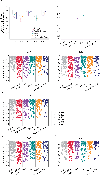Social odors drive hippocampal CA2 place cell responses to social stimuli
- PMID: 39743170
- PMCID: PMC11827691
- DOI: 10.1016/j.pneurobio.2024.102708
Social odors drive hippocampal CA2 place cell responses to social stimuli
Abstract
Hippocampal region CA2 is essential for social memory processing. Interaction with social stimuli induces changes in CA2 place cell firing during active exploration and sharp wave-ripples during rest following a social interaction. However, it is unknown whether these changes in firing patterns are caused by integration of multimodal social stimuli or by a specific sensory modality associated with a social interaction. Rodents rely heavily on chemosensory cues in the form of olfactory signals for social recognition processes. To determine the extent to which social olfactory signals contribute to CA2 place cell responses to social stimuli, we recorded CA2 place cells in rats freely exploring environments containing stimuli that included or lacked olfactory content. We found that CA2 place cell firing patterns significantly changed only when social odors were prominent. Also, place cells that increased their firing in the presence of social odors alone preferentially increased their firing during subsequent sharp wave-ripples. Our results suggest that social olfactory cues are essential for changing CA2 place cell firing patterns during and after social interactions. These results support prior work suggesting CA2 performs social functions and shed light on processes underlying CA2 responses to social stimuli.
Keywords: CA2; Hippocampus; Place cells; Social cognition; Social memory; Social odor.
Copyright © 2025 Elsevier Ltd. All rights reserved.
Conflict of interest statement
Declaration of Competing Interest The authors declare that they have no known competing financial interests or personal relationships that could have appeared to influence the work reported in this paper.
Figures






Update of
-
Social odors drive hippocampal CA2 place cell responses to social stimuli.bioRxiv [Preprint]. 2024 Sep 19:2024.07.16.603738. doi: 10.1101/2024.07.16.603738. bioRxiv. 2024. Update in: Prog Neurobiol. 2025 Feb;245:102708. doi: 10.1016/j.pneurobio.2024.102708. PMID: 39071428 Free PMC article. Updated. Preprint.
References
-
- Almeida-Santos AF, Carvalho VR, Jaimes LF, de Castro CM, Pinto HP, Oliveira TPD, Vieira LB, Moraes MFD, & Pereira GS, 2019. Social isolation impairs the persistence of social recognition memory by disturbing the glutamatergic tonus and the olfactory bulb-dorsal hippocampus coupling. Scientific Reports, 9, 473. 10.1038/s41598-018-36871-6 - DOI - PMC - PubMed
-
- Chen S, He L, Huang AJY, Boehringer R, Robert V, Wintzer ME, Polygalov D, Weitemier AZ, Tao Y, Gu M, Middleton SJ, Namiki K, Hama H, Therreau L, Chevaleyre V, Hioki H, Miyawaki A, Piskorowski RA, McHugh TJ, 2020. A hypothalamic novelty signal modulates hippocampal memory. Nature, 586(7828), 270–274. 10.1038/s41586-020-2771-1 - DOI - PubMed
MeSH terms
Grants and funding
LinkOut - more resources
Full Text Sources
Miscellaneous

